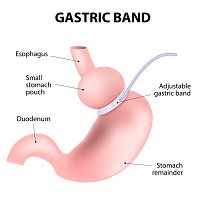Article
Comparing Bone Loss and Weight Loss Associated with Gastric Bypass and Gastric Banding Surgeries
Author(s):
Researchers report that weight loss and increases in bone turnover were greater after one year among patients who underwent Roux-en-Y gastric bypass compared to patients who had laparoscopic adjustable gastric banding procedures.

Gastric bypass surgery leads to high-turnover bone loss over time. Little is known about differential effects of various bariatric procedures or the mechanisms underlying skeletal changes.
At ENDO 2015, Elaine Wei-Yin Yu, MD, MSc, assistant professor of medicine at Massachusetts General Hospital in Boston, MA, presented results from a study that tested the hypothesis that Roux-en-Y gastric bypass (RYGB) would be associated with greater skeletal changes than laparoscopic adjustable gastric banding (LAGB) and that RYGB has weight loss-independent effects on bone that can be observed even before significant weight loss occurs.
Study participants with type 2 diabetes underwent either RYGB (n=11) or LAGB (n=8). They were studied at baseline (pre-operatively), 10 days post-operatively and at 1 year after surgery.
Yu and her colleagues examined fasting and postprandial changes in various bone metabolic markers during a mixed meal tolerance test (at 0, 30, 60, and 120 minutes). The markers were serum C-terminal telopeptide (CTX), procollagen type 1 (P1NP), parathyroid hormone (PTH), and polypeptide YY (PYY), a potential gut-derived mediator of bone turnover that may negatively regulate osteoblast activity. Yu said that PYY was the main focus of the study.
Baseline weight (107 ± 4 kg), age (54 ± 2 yrs) and gender (48% female) were similar in RYGB and LAGB groups and there were no differences in baseline fasting 25-hydroxyvitamin D (25 ± 3 ng/mL), PTH (42 ± 3 pg/mL), CTX (0.24 ± 0.03 ng/mL), P1NP (36 ± 3 µg/L) or PYY (32 ± 4 pg/mL).
Ten days after surgery, weight loss was equivalent after RYGB (-7 ± 1 kg) and LAGB (-6 ± 1 kg), but the increase in fasting CTX was greater after RYGB than LAGB (69 ± 23% vs. 12 ± 12%, p<0.001). P1NP was unchanged in both groups at 10 days post-operatively.
By 1 year, weight loss after RYGB exceeded that of LAGB (-30 ± 3 kg vs. -8 ± 2 kg, p<0.001), and fasting CTX, P1NP, and PYY were significantly higher in the RYGB group than in the LAGB group (CTX 221 ± 60% vs. 15 ± 6%, p<0.001; P1NP 93 ± 25% vs. -9 ± 10%, p<0.001; PYY 38 ± 7% vs. 29 ± 8%, p<0.030).
After RYGB, serum 25-hydroxyvitamin D levels were higher while PTH levels were unchanged, likely reflecting aggressive vitamin D supplementation, according to Yu. Postprandial suppression of CTX and increase in PYY were more pronounced after RYGB than LAGB at 10 days and 1 year (p<0.001 overall). Postprandial PTH patterns did not change appreciably after either RYGB or LAGB. Changes in CTX were not significantly associated with changes in fasting or postprandial PYY.
In summary, the researchers found that increases in bone remodeling indexes were measureable as early as 10 days after RYGB but not after LAGB, despite comparable initial weight losses. Proportional increase in the resorptive marker CTX was greater than the formation marker P1NP. Taken together, these data suggest a RYGB-specific and weight loss-independent increase in bone resorption. At 1 year, both weight loss and increases in bone turnover were greater after RYGB than after LAGB. Yu pointed out that the mean 1-year weight loss for the LAGB surgery group (about 8%) was about half of that anticipated based on reports in the literature and other experience.
Although the mechanisms remain to be identified, the increased responsiveness of CTX to postprandial suppression after RYGB suggests that alterations in gut hormones may play a role in RYGB-specific skeletal changes.
A questioner asked if there were changes in leptin during the study and, consequently, whether there were changes in vitamin D availability wholly attributable to vitamin supplementation. Yu said they had not measured leptin but she was aware of previous studies that showed changes in PTH associated with leptin.
Another member of the audience asked about the suggested effect of PYY on bone metabolism and whether Yu had any insights into what might be the mechanism of action. Yu said the concept was controversial but there was some supportive data in the literature.





